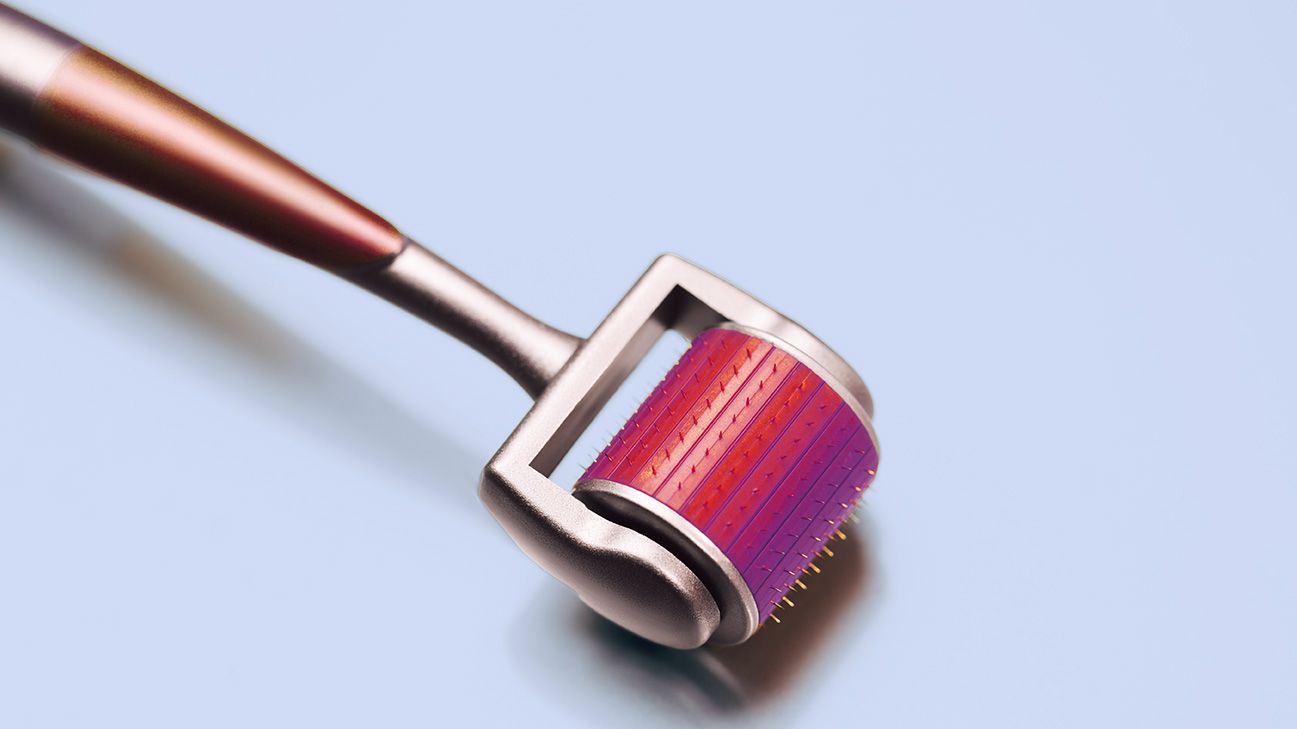DIY dermarolling comes with risks like scarring or infection. But with proper technique and sanitization, you can dermaroll solo safely.
Microneedling, also known as dermarolling, is a method that uses tiny needles to puncture the skin. It’s believed to thicken the skin, diminish fine lines and wrinkles, and lessen hyperpigmentation.
Now, you don’t need to visit a dermatologist for microneedling. You can easily buy a dermaroller online at a much lower cost. But, is using a spiky device at home safe and effective?
Here’s what to know before you get rollin’.

When you’re wounding the skin repeatedly, there’s always some risk involved. According to the Food and Drug Administration (FDA), potential side effects of microneedling include:
- redness
- burning
- itching
- irritation
- bleeding
- crusting
- peeling
- roughness
Less common side effects include:
- hypo- or hyperpigmentation
- swollen lymph nodes
- infection
You can minimize risks by following proper sanitization practices and using a cosmetic-grade device. Though they’re readily available, so far, the FDA hasn’t approved dermarollers with needles longer than .3 mm (which is considered a medical device), for at-home use.
Other candidates who are prob not a good fit for microneedling include those who have:
- rosacea
- active breakouts
- very thin skin
- sensitive skin
Basically, if the skin is inflamed, sensitive, or has acne, take it slow.
If you’re ready to get rolling, here’s how:
- Disinfect the device in 70 percent isopropyl alcohol for 5–10 mins.
- Cleanse your skin with a gentle cleanser and apply a swab of alcohol to sanitize the area.
- Gently roll the device over the treatment area vertically or horizontally, until you’ve covered the entire area about 2–3 times. Take care to lift the roller after each swipe.
- Thoroughly rinse your face with water and pat dry.
- Apply serum and moisturizer. Derm-approved picks include vitamin C, hyaluronic acid, or peptide serums.
- Clean the device with dish soap.
- Disinfect the device again in rubbing alcohol for 5-10 mins.
Safety tips
- Inspect the device for any damaged pieces before each use.
- Replace your roller regularly. With repeated use, the needles can erode and potentially harm the skin.
- Start with .2mm devices and work your way up over time. Your skin will build tolerance while you get the hang of handling the device.
- Avoid dermarolling rashes, acne, moles, etc.
- Avoiding dermarolling too deeply into the skin in general – not only for the ouch factor, but also to protect your skin from scarring.
- Avoid sensitive areas like under the eyes and brows. (But since we’re not your mom, if you *must* try to tackle those dark circles, use the shortest needle length and practice extra care. And know that going to a pro is still def advised instead!)
- Avoid using harsh chemical serums before or after rolling. Save the salicylic acid, benzoyl peroxide, and retinoids for after your skin has healed from the needles.
- Always load up on SPF the day after microneedling to prevent sun damage. You should apply it anyway, but it’s extra crucial when your skin is still tender.
- Be sure to use a clean pillowcase and towels after rolling. In general, you wanna keep your hygiene 10/10 while your skin heals.
- If you notice severe pain, redness, or irritation that persists for more than 2 hours, contact a doctor. You may have an infection that needs urgent care. 🚨
In general, experts recommend dermarolling about 3x/week for shorter needles (.2mm) and every 2-4 weeks for long ones (.2 mm+).
That’s because when you use longer needles, your skin naturally needs longer to heal. If you do it too often, you risk irritating, damaging, or scarring your skin.
Here’s the breakdown:
- .2 mm: every other day
- .5 mm: 1-3x/week
- 1 mm: 2x/month
- 1.5 mm: every 3-4 weeks
You can find microneedling devices from .2 to 1.5 mm at outlets like:
- Amazon
- Ulta
- Sephora
- Target
- Walmart
Devices over 1.5 mm are not recommended nor readily available for at-home use.
Pro tip: Not sure what needle size you need? Note your skin concerns. Fine lines can be rolled out with shorter needles, while deeper wrinkles may need at least 1 mm to see results.
Looking for support for hair growth or removal? These days, there are also specific devices like:
- microneedling/hair removal combo tools
- scalp dermarollers for hair growth
Dermarolling does come with benefits, but it takes specialized care (and lots of sanitizing) to minimize risks at home.
For safer or more dramatic results, always go to a pro.

